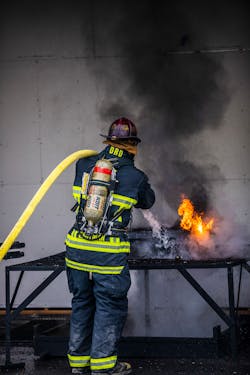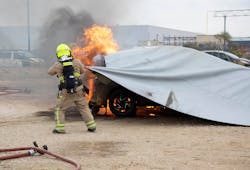Hybrids & Electric Vehicles: Is the Fire Service Ready?
Many of us are familiar with headlines about electric vehicles (EVs) that were engulfed in flames and firefighters dumping some 30,000 gallons of water on them and battling the blaze for hours. Likewise, many of us surely have trepidation about the high-voltage (HV) orange cables that are under the hood and whether we can get shocked. Also, a significant number of these vehicles utilize the latest high-strength designs, which make them challenging for extrications. These issues represent a trifecta of difficulties for emergency services. No doubt, we are an amazing and industrious group when it comes to overcoming obstacles. However, too often, we develop new strategies, techniques and resources reactively rather than proactively. The hybrid/EV industry is growing at such a radical rate that it’s mimicking a sort of industrial revolution—one that we aren’t prepared for.
How do responders avoid getting caught in or creating a fire event or a shock hazard?
Batteries in hybrids & EVs
Until relatively recently, encountering hybrids and EVs was like encountering Bigfoot: They were elusive and rare, and most firefighters never had to interact with them. A recent study from BloombergNEF that was published in Forbes projects that EVs will comprise 28 percent of global passenger vehicle sales by 2025 and 58 percent by 2040. The United States hadn’t led the charge in the EV industry until 2018, when the country outpaced the international market, rising 80 percent in the production and sales of EVs. As an example of domestic commitment, General Motors plans to invest $2 billion in six domestic EV assembly plants.
Every fire department, law enforcement agency, tow/recovery organization and collision/storage facility must prepare for the potential hazards of hybrids and EVs. To do this, we must understand the hazards in the context of our job.
First and foremost, I passionately believe that hybrids and EVs are safer technologies than combustion engine vehicle technology. I equate hybrids and EVs to airplanes. Traveling by airplane is much safer than traveling by automobile, but when something goes wrong on an airplane, the results are typically much more catastrophic than when something goes wrong on an automobile. Hybrids and EVs are incredibly well-designed today, including a wide range of proprietary design features that almost eliminate the potential for significant hazards to develop—right up to the point at which the automobile experiences something that’s outside of its design specifications. This isn’t unique to hybrids and EVs. All of today’s automobiles are designed to withstand impacts from almost any direction and very effectively protect the occupants. However, when an automobile travels at 120 mph or has a collision with a massive force, the automobile experiences something that’s beyond the scope of its design, and bad things occur.Potential hazards
Our job typically involves getting called when things went wrong. To establish what can go wrong, one must know the basic things that EV batteries don’t respond well to:
Trauma: EV batteries have little tolerance for impacts that cause penetration or significant compression. This causes the batteries to heat up and to release pressurized gases that are both toxic and flammable. Penetrating traumas often result in immediate ignition. Typically, the fire will burn until the batteries are all consumed or until they become isolated by other melting materials that act as insulators. This particularly can be hazardous, because it might result in stranded energy on elements that look like piles of debris. Think of arc flashes that emanate from molten piles of plastic that conceal live battery cells.
Heat: EV batteries operate safely when they are in a specific temperature range. When the upper end of that range is exceeded significantly, the batteries can heat and swell and go into thermal runaway. This can be a result of external fire exposure or what’s referred to as electro-chemical abuse, which is overcharging, overdischarging or internal short-circuiting. Short-circuiting also can create malfunctions in electrical system design, which allows contact by personnel with HV components or compromised portions of the automobile to result in shock or arc flash.
To better understand thermal runaway, think of it as simply an exothermic event in which a battery cell reaches a critical temperature range and starts to decompose, which causes a self-sustaining thermal event. As heat increases, decomposition increases, until the cell ruptures, which allows all of the energy to affect the adjacent cells, and the cascading event occurs. The only way to effectively extinguish these events is to cool the cells.
Regarding shock or arc potential, recognize that the HV components that are on today’s automobiles are incredibly well-protected. Typically, they don’t present any hazard unless the automobile is submerged or encounters large volumes of water exposure or fire or a collision that compromises the HV battery system or the HV cable. In these types of events, the fail-safes that would isolate the DC voltage of the battery might look for a point of contact to complete a circuit and result in an HV shock.How to avoid hazards
Verify that the automobile is a hybrid or EV. (Ron Moore provided a great article recently on hybrid and EV identification [firehouse.com/21130300].) Once you confirm that the automobile is a hybrid or an EV, get help.
That help is a new resource, the Energy Security Agency (ESA). Also, the National Highway Traffic Safety Administration, the NFPA and SAE International all released federal recommendations/guidelines that encourage both first and second responders to seek expert guidance before interacting with a hybrid or EV that’s compromised. The ESA provides a 24-hour call service (855-ESA-SAFE) that’s staffed with hybrid and EV experts who have a state-of-the-art reference database and analysis protocol to guide callers through safe and compliant interactions. The free service provides real-time guidance regarding automobile design and EV management as well as the list of criteria that’s required to safely evaluate an automobile’s hazard level.
Attempting to stay up-to-date on all of the unique characteristics of each hybrid and EV and to find real-world recommendations is an overwhelming task for anyone who is on scene of an event. Use the resource and make your life easier.
Automobile manufacturers develop Emergency Response Guides; condensed versions of them are known as Quick Guides. Some of the guides that are in the Emergency Response Guidebook are very comprehensive; although extremely thorough and helpful as a study and learning tool, they can be 20–30 pages in length and can prove difficult to navigate when you’re involved in an emergency. The Quick Guides provide more-limited information pertinent to emergent situations. However, some manufacturers and specific automobiles aren’t covered by Emergency Response Guides, so you are left to guess.
Mobile apps and online services provide reference materials for identifying locations and basic procedures for shutdown and interaction with hybrids and EVs.
Hands-on or hands-off
When preparing for extrication, I suggest that you approach the automobile as more of a general rescue. Tools that you should be armed with for the 360 assessment should include a thermal imaging camera (TIC) and a four-gas meter.
Open up the automobile early by opening the doors or by taking the glass, to allow the vehicle to ventilate. What looks like air bag smoke could be the initial off-gassing of batteries. Be particularly focused on high concentrations of carbon monoxide (CO).
Another important indicator of a thermal battery event is an odor that we often refer to as “cherry bubblegum.” Lithium-ion (li-ion) batteries produce a unique and sweet odor when they approach thermal activity. The combination of odor and CO should be an immediate alert to go into rapid rescue mode and to establish suppression lines. Full PPE, including SCBA, should be donned at all times until the potential for a thermal event is disproven in your assessment.
The TIC also will be a strong indicator. The ESA can guide you to the location of the HV battery and additional components, and a strong thermal indication on your camera at those locations should clue you in to “angry” batteries, particularly if you have a hot spot within the HV battery pack.
If you detect the presence of an impending thermal event, get the victim out of the automobile as soon as possible and get prepared to go into firefighting mode.
Don’t release these vehicles to a tow company without expert guidance and further assessment. The automobiles must be made safe prior to transport, or they can develop into a fire ball on the back of the tow truck or at the storage yard hours or days later.
If you eliminate the presence of a thermal event, put the automobiles into safe mode by de-energizing them. This also requires guidance. Hybrids and EVs have different disconnect procedures per the manufacturers. The most comprehensive way to de-energize the automobile is to perform a manual disconnect of the HV system. However, this technique is considered by many to be a specialized practice that only should be performed by a qualified and trained individual who has proper PPE and tools. Untrained and improperly protected attempts to perform manual disconnects of the HV battery can result in shock or arc flash.
The predominant disconnect method using the low-voltage (12-volt) system involves cutting specific loops and cables and/or removing specific fuses/relays. In many automobiles, these are identified with labels and icons that depict safe cut zones, and they use specific color codes to indicate their effect on either 12-volt, HV or both systems. Again, the color codes and icons can be difficult to retain and apply when you are on scene, so don’t hesitate to seek expert guidance.
Even after access points are managed according to the manufacturer’s guidelines, the HV system still has live energy in it.
Extrication
To initiate extrication techniques, you might need to rethink your approach.
The most important information that you must apply is the location of the HV components. Remember the rules about what makes li-ion batteries misbehave: trauma and heat. Don’t compress areas of the automobile where the HV cable or the HV battery(ies) is located. Often, the HV battery is in the rear of the automobile or under the rear seat or encompasses the entire floorpan.
Many dash techniques involve posting (applying the base of the tool or the tip that you want to stay fixed) to areas where the battery(ies) would be located. Applying force to the rocker with a ram to push the A-post could deflect the rocker and compress the floorpan, thus applying pressure (trauma) to the battery. Setting spreader tips inside of the rocker and contacting part of the floorpan to do a blind dash lift could compromise the battery casing. If a metal contact point, such as a tool tip, punches through the body metal of the vehicle and the battery casing, you penetrate the battery, which could cause an immediate electrical interaction as well as a thermal reaction.
Other techniques to be careful with are interior cross-ramming. We often attempt to displace B-posts or dash assemblies by posting rams on seatbelt bases or structural points on the floorpan and around the seat anchors. Many of these points might be in close proximity to the HV components and shouldn’t be used.
Maintain four-gas monitoring and thermal image monitoring throughout the extrication and ensure that charged lines are down, with suppression crews at the ready. Stay alert for the cherry bubblegum smell and sounds or visual signs of sparking or gas releases. Presume that fluids that come from the vehicle are battery coolant and might reflect potential damage to the battery. The coolant typically is glycol-based and is similar to standard automobile coolant.
About the Author
Dalan Zartman
Dalan Zartman is a 20-plus-year career firefighter who is assigned to a heavy rescue in Ohio. He is a rescue instructor, a certified Firefighter II and rescue specialist, a public safety diver and a paramedic. Zartman is president and founder of Rescue Methods LLC, which is an international training and consulting group that provides technical rescue training/consulting and alternative energy research, training and testing under the auspices of Bowling Green State University. You can reach him at [email protected].


